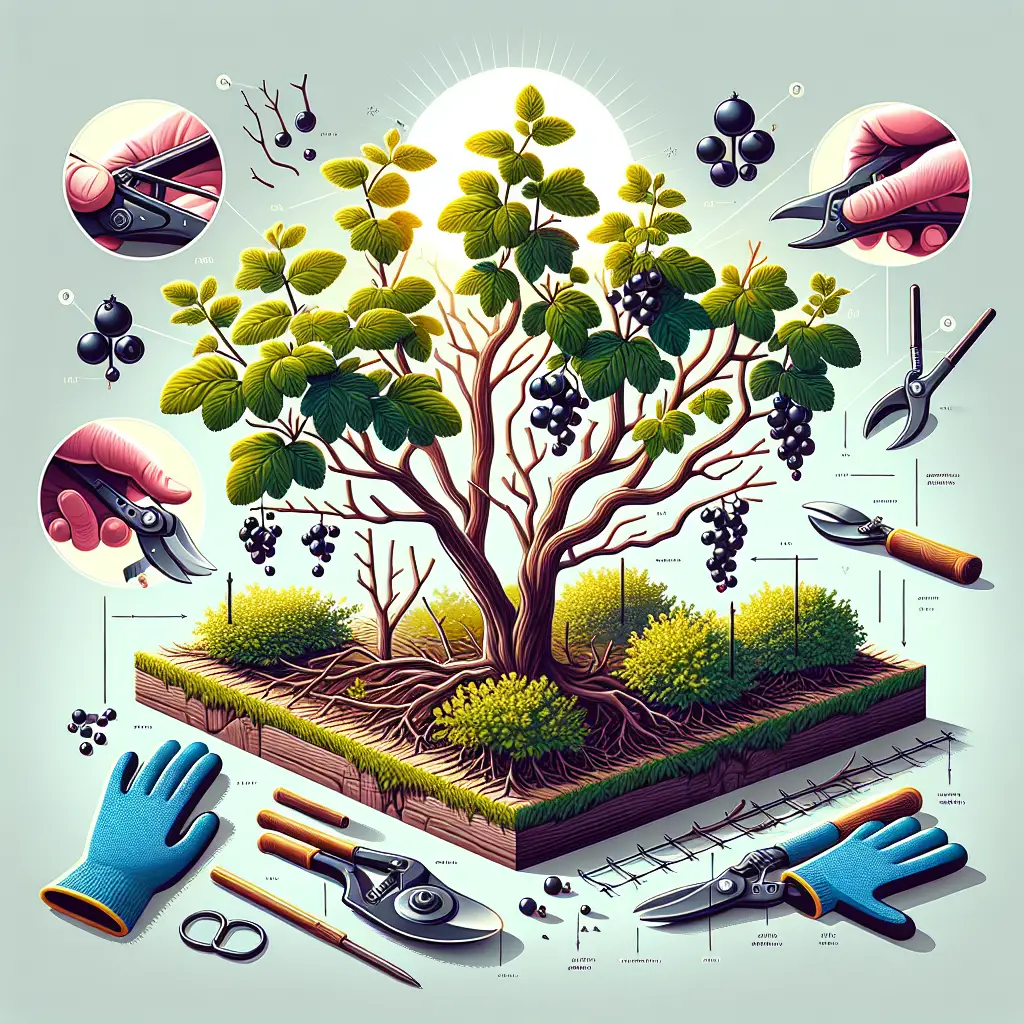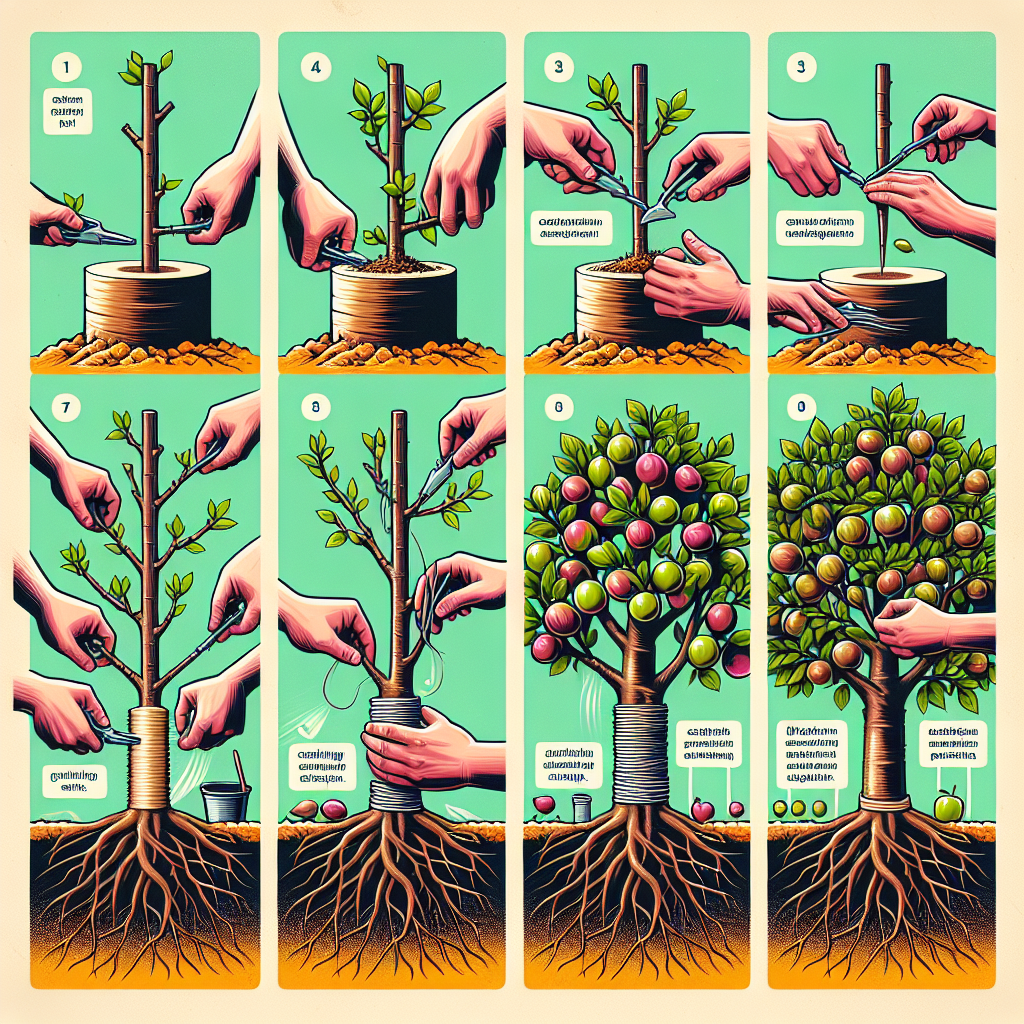Pruning Techniques for Black Currant Bushes
Updated July 12, 2024 at 7:18 pm

Understanding Black Currant Bushes
- Pet Friendly
Black currant bushes are non-toxic to pets, making them a safe choice for gardens that might be explored by curious animals.
- Light Requirements
These bushes prefer full sun to partial shade, ensuring they receive at least 4-6 hours of sunlight daily to thrive and produce fruit.
- Watering
Provide consistent watering, especially during dry spells, to maintain moist soil but avoid waterlogging which can lead to root issues.
- Humidity
Black currants are resilient to different humidity levels but perform best in moderate conditions without prolonged dry or overly wet air.
- Temperature
They can withstand cold winters, but frost during flowering can impact fruit set, thus requiring consideration of local climate.
- Difficulty
While black currant bushes are relatively easy to care for, understanding pruning techniques is key to maintaining a healthy and productive plant.
Why Pruning Black Currant Bushes is Essential
Pruning is not just about shaping your black currant bushes; it’s a vital practice that encourages healthy growth and abundant fruit production.
Regular pruning helps prevent disease by improving air circulation, removes dead or diseased wood, and encourages new growth that will bear fruit.
Optimal Timing for Pruning Your Black Currant Bushes
To achieve the best results, pruning should be done during the plants dormant season, typically in late winter or early spring before new growth begins.
However, keep an eye on weather conditions, as you’d want to avoid pruning during extreme cold spells which can harm freshly cut branches.
Types of Cuts: Understand Before You Snip
Knowing the right type of cut is crucial. There are primarily two types: heading cuts, which encourage bushier growth, and thinning cuts, which remove entire branches to improve structure.
For black currants, thinning cuts are generally preferred to maintain an open center and allow light penetration, vital for fruit development.
The Step-by-Step Guide to Prune Black Currant Bushes
Start by removing any dead or diseased wood, which is usually darker and may have signs of fungal infection.
Then, move on to thinning out older branches. Black currant bushes fruit best on one and two-year-old wood, so removing older branches stimulates growth of new fruit-bearing shoots.
Tools of the Trade
A high-quality pair of pruning shears is your best friend when it comes to pruning. They should be sharp and clean to ensure precise cuts and reduce the risk of spreading disease.
For thicker branches, a pair of loppers may be necessary. Ensure they are well-oiled and maintained for the best performance.
Product Spotlight: Fiskars Steel Pruning Shears
The Fiskars Steel Pruning Shears are acclaimed for their durability and precision, making them ideal for snipping those black currant branches.
These shears have a bypass blade design, providing a clean cut that is essential for healthy regrowth and avoiding damage to your plants.
Pros:
- Hardened steel blade stays sharp through heavy use
- Non-stick coating helps shears glide through wood without gumming up
- Ergonomic handle comfortable for prolonged use
Cons:
- May be difficult for users with smaller hands to handle
- Not ideal for branches thicker than 3/4 inches
Find This and More on Amazon
How to Identify and Cut Suckers and Water Sprouts
Suckers are shoots that grow from the base of the bush, while water sprouts shoot up from branches, both of which can drain energy from fruiting wood.
Identify these vigourous growths early and prune them back to the base to direct the bushes energy back into producing fruit.
When and How to Prune for Shape
After you have taken care of the health and productivity aspects, you can prune for shape. This is usually done after the bush has been thinned out.
Create an even, balanced structure leaving the strongest, most vigorous branches for a well-maintained bush and easier harvest.
Maintaining Your Pruning Tools
Keeping your tools clean and sharp ensures that every cut you make is clean, which is crucial in preventing disease and promoting fast healing.
After each use, clean your tools with soap and water, dry them thoroughly, and store them in a dry place to prevent rust and corrosion.
Annual Pruning vs. Rehabilitative Pruning
Annual pruning is about maintaining your bush, keeping it in optimal health. It involves light, regular cuts to manage growth and fruit production.
Rehabilitative pruning is more aggressive, which might be necessary if you inherit a neglected bush. This type of pruning is meant to rejuvenate old or overgrown plants.
Recognizing Disease During Pruning
While pruning, its important to be vigilant for signs of disease, like discolored leaves or stems, which may indicate issues like powdery mildew or currant blister aphid.
Remove any infected parts well below the affected area to help prevent the spread of disease and dispose of them properly, not in your compost.
Aftercare: Post-Pruning Best Practices
Once pruning is done, give your black currant bush some TLC. A layer of fresh mulch can help conserve moisture and suppress weeds.
It’s also a great time to test the soil and add any necessary amendments, like a balanced fertilizer, to ensure your bush has all it needs to recover and grow.
Gearing Up for Next Year’s Pruning
As the growing season progresses, keep notes on your bushes development. This helps plan next year’s pruning routine for an even more bountiful harvest.
Remember, each year your bush will grow differently, so adjust your pruning technique accordingly for continual improvement.
Mindful Pruning for Bountiful Harvests
By understanding the principles of pruning black currant bushes, you’re not just maintaining a garden, you’re cultivating a thriving, fruit-bearing sanctuary.
With the right knowledge, tools, and care, your black currant bushes can be both a beautiful addition to your garden and a deliciously fruitful endeavor.
Understanding Black Currant Bush Variety Differences
Not all black currant bushes are alike; varieties such as ‘Ben Nevis’, ‘Ebony’, and ‘Titania’ have their quirks when it comes to pruning.
Some varieties may bear fruit earlier or have more vigorous growth, which could slightly alter your pruning routine to maximize their yield.
How to Distinguish Fruiting Wood from Non-Fruiting Wood
Fruiting wood on black currant bushes is typically lighter in color and has plumper buds, whereas non-fruiting wood often appears older and more gnarled.
Knowing the difference is key to pruning correctly, as you’ll want to retain the productive branches and remove older, less fruitful ones.
Encouraging Strong Root Development with Proper Pruning
A sturdy root system is crucial for the health of your black currant bushes. Careful pruning can stimulate healthy root growth, ensuring a steady supply of nutrients and water.
Removing the upper part of the plant reduces the demand on the roots, allowing them to grow stronger and support new above-ground growth.
Combating Pests and Diseases with Pruning
Black currant bushes are susceptible to pests such as gooseberry sawfly and big bud mite.
Pruning can help control these pests by eliminating their hiding places and breeding grounds, keeping your bushes healthy.
Preparing for Winter: Pruning for Cold Hardiness
Proper pruning not only shapes your bush but also prepares it for the harshness of winter.
By removing weaker branches, you reduce the risk of breakage under the weight of snow and promote the hardiness of remaining limbs against freezing temperatures.
Product Spotlight: ARS Professional Loppers
The ARS Professional Loppers are designed for gardeners who need to tackle larger branches without straining themselves.
With their sharp, heavy-duty blades and long handles, they make short work of thick currant branches, ensuring clean cuts and fast healing.
Pros:
- Superior cutting power for branches up to 2 inches thick
- Lightweight aluminum handles for easy maneuverability
- Replaceable blades extend the life of the loppers
Cons:
- Higher price point than some competitors
- May be too large for very fine or delicate pruning work
Find This and More on Amazon
Integrating Pruning with Overall Black Currant Care
Pruning should be a component of your overall black currant bush care, which includes proper fertilization, pest control, and watering.
Each element complements the others, leading to a more prolific bush and harvest.
Pruning for Different Training Systems: Open Center vs. Cordon
Whether you’re growing your black currants in traditional open center style or as cordons (single-stemmed plants), the pruning technique will differ.
Research the method best suited to your garden space and black currant variety.
Common Mistakes to Avoid When Pruning Black Currants
One of the most common mistakes is over-pruning, which can stress the bush and lead to poor yields.
Another mistake to avoid is neglecting to prune at all, which can lead to a dense, disease-prone plant.
Maximizing Fruit Size with Selective Pruning
By selectively pruning your black currant bushes, you allow more resources to be directed to fewer fruiting buds, which can lead to larger and more succulent berries.
It’s a delicate balance to find but well worth the effort for those premium fruits.
Balancing Pruning and Wildlife: How to Encourage Beneficial Creatures
While you’re pruning, consider leaving some areas of your black currants a little wilder to attract beneficial insects and birds, which can help control pests.
A varied pruning approach can create a harmonious ecosystem in your garden.
Championing Eco-Friendly Pruning Practices
Environmentally mindful pruning includes composting your cuttings (if not diseased) and avoiding chemical treatments.
Healthy pruning practices contribute not only to your bushes but also to the overall health of your garden’s ecosystem.
Making the Cut: A Hands-On Pruning Workshop
Consider attending a pruning workshop or inviting a horticulturist to your garden.
Hands-on learning can give you confidence in your pruning decisions and techniques.
Expert Advice: Consulting with a Local Agronomist
Local agronomists or extension agents can offer tailored advice for pruning black currants in your specific climate and conditions.
They can provide insights based on years of experience and knowledge of regional plant health concerns.
Product Spotlight: Corona Anvil Pruners
Corona Anvil Pruners are another excellent tool for those tricky, thicker branches that need a bit more force.
With their anvil style design, they are great for tough, woody cuts without causing strain on your hands.
Pros:
- Powerful anvil action for cutting hard wood
- Non-slip grips for secure handling
- Built-in sap groove to reduce blade stickiness
Cons:
- Not suitable for precise or delicate thinning cuts
- Anvil pruners can crush softer stems if not used correctly
Find This and More on Amazon
Living Soil: Enhancing Soil Health Post-Pruning
After pruning, consider adding beneficial organisms or organic matter to your soil, fostering a ‘living soil’ that continuously feeds your black currants.
This approach can lead to healthier plants that are more resistant to disease and pests.
Observing Nature: Learning From Wild Black Currants
Take note of how wild black currants grow and regenerate; mimic these natural patterns where possible to tap into the innate resilience of the species.
Nature often has time-tested strategies that can be emulated in our gardens.
Celebrating the Season: Harvest Festivals and Pruning Demonstrations
Participate or organize local harvest festivals, where pruning demonstrations can be both educational and celebratory, recognizing the fruits of your labor.
Such events are great for community building and sharing knowledge.
Mindful Pruning for Bountiful Harvests
Through prudent, considerate pruning, you build a relationship with your black currant bushes, leading to seasons of bountiful harvests.
Maintain the balance between the technical and the intuitive, and your garden will not only be fruitful but a place of beauty and abundance.
Utilizing Pruning to Control Black Currant Bush Size and Productivity
Proper pruning techniques help manage the size of black currant bushes, ensuring they do not become too large for their space.
More importantly, strategic cutting back promotes an optimal balance between vegetative growth and fruit production, leading to a higher yield.
Revitalizing Old Black Currant Bushes Through Renovation Pruning
Even mature and neglected black currant bushes can be brought back to a productive state with renovation pruning.
By gradually removing old wood over several seasons, you can rejuvenate an old bush without over-stressing the plant.
The Role of Sunlight: Pruning for Optimal Light Exposure
Black currant bushes require abundant sunlight to fruit well. Pruning can significantly improve light penetration to lower branches, which in turn encourages better fruit development.
Open up the canopy to ensure even the inner branches receive their fair share of sunshine.
Companion Planting Considerations When Pruning
When planning out your garden landscape, consider how pruning your black currants will affect their plant neighbors.
Ensure that your pruning strategy allows for complementary growth and does not shade out other sun-loving plants in your garden.
Preserving Garden Aesthetics with Tactical Pruning Techniques
While function is crucial, form is also important. Smart pruning can help shape your black currant bushes into an attractive form, enhancing the overall aesthetics of your garden.
Thoughtful cuts can maintain both the productivity and visual appeal of your plants.
Documenting Pruning: Keeping a Garden Journal
Keep a garden journal to record your pruning activities, noting what works and what doesn’t, to refine your techniques year over year.
Photos and notes can serve as valuable references to improve your pruning strategy.
Respecting Nature’s Cycles: Timing Pruning with Life Stages
Black currant bushes have different needs at various stages of their life cycle. Adjusting your pruning technique to align with these stages can make all the difference in their vitality and fruit production.
Understand the full cycle from dormancy to harvest to utilize pruning most effectively.
Choosing the Right Pruning Method for Your Black Currant Varieties
Different black currant varieties may respond better to different pruning methods. Research and select the method that aligns best with the specifics of the varieties you are growing.
Adapt your techniques to match the natural growth habit of your bushes for optimal results.
Community Engagement: Sharing Pruning Successes and Failures
Engaging with other gardeners in your community can provide a wealth of knowledge. Share your successes and failures in pruning black currants to foster a supportive gardening community.
Learning from others can help avoid common pitfalls and promote best practices.
Planning for Diversity: Pruning to Support Multiple Berry Varieties
If you grow multiple berry varieties alongside your black currants, your pruning approach can have wider implications. Plan your pruning to complement the growth and fruiting times of your entire fruit garden.
This thoughtful approach can lead to a staggered and extended harvest season.
Embracing the Rhythm: The Therapeutic Benefits of Pruning
Aside from its practical benefits, pruning can be a therapeutic activity. Many gardeners find the rhythmic nature of pruning to be meditative and stress-relieving.
Embrace the peacefulness of the task and enjoy the quiet time with your plants.
Pruning and Propagating: Growing New Black Currant Bushes
Pruning isn’t just about maintenance; it’s also a chance to propagate. Use healthy cuttings from your pruning sessions to grow new black currant bushes, expanding your garden or sharing with friends and neighbors.
This is a sustainable way to increase your crop without additional cost.
Incorporating Artistic Elements into Pruning
With a bit of creativity, pruning can transform your black currant bushes into living sculptures. Consider artistic pruning techniques that allow you to infuse both beauty and productivity into your garden design.
Turning functionality into artistry, your garden can be a canvas for expression.
Pruning as a Family Activity: Getting Everyone Involved
Pruning can be a learning experience for the whole family. Getting everyone involved not only lightens the workload but also teaches valuable gardening skills.
Make pruning a family affair and enjoy the quality time together outdoors.
Understanding the Impact of Climate Change on Pruning Practices
Climate change can alter the timing and necessity of certain pruning practices. As weather patterns shift, so too might the ideal pruning window for your black currant bushes.
Stay informed and adaptable to continue providing the best care for your plants.
Enduring the Seasons: Reflecting on Years of Pruning
Pruning is a yearly ritual that marks the passage of time in a gardeners life. It’s a chance to reflect on the growth and changes not only in your plants but in your own gardening journey.
Celebrate each year’s pruning as a milestone in your continuous relationship with nature.
.
Shop more on Amazon

